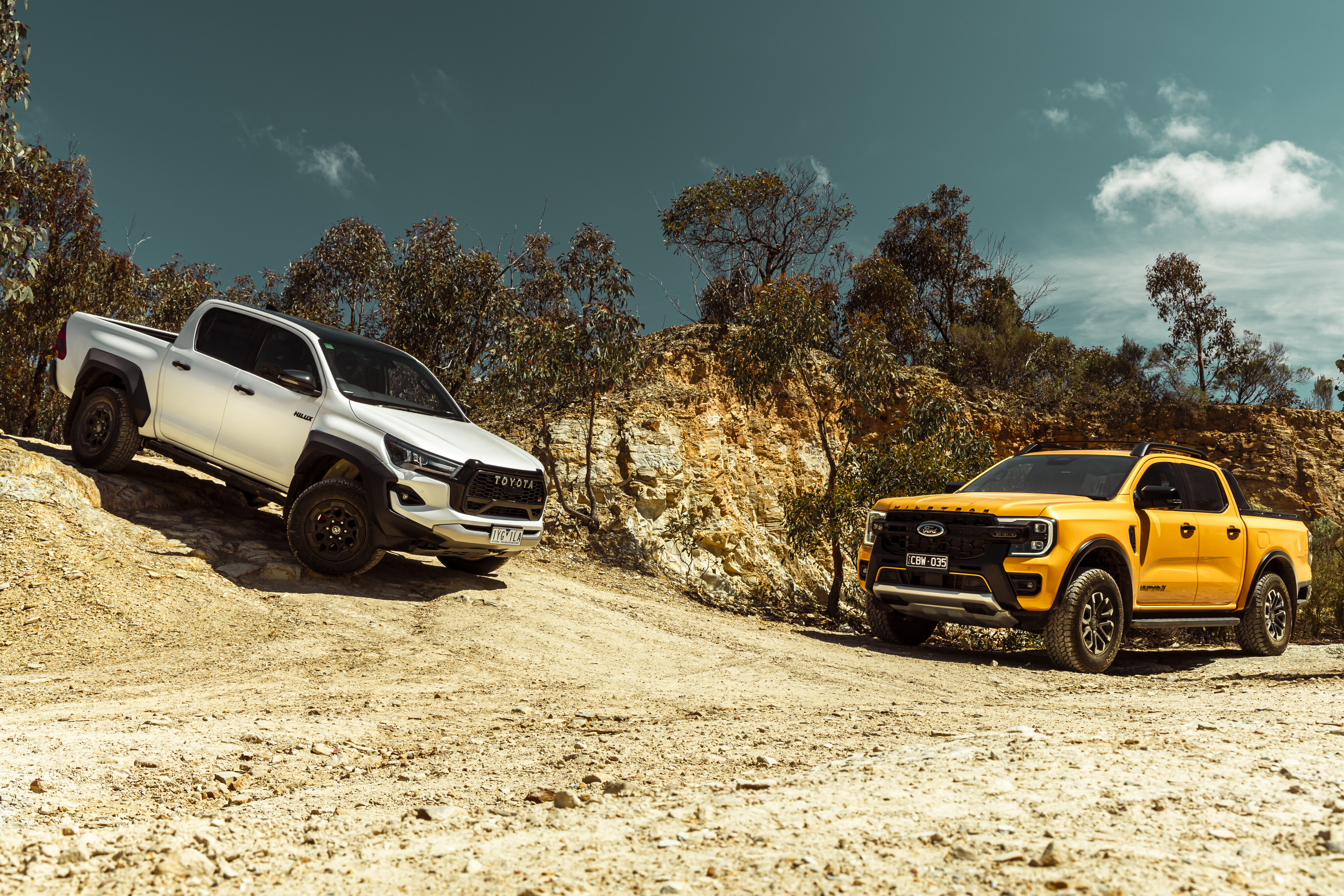
Ford Ranger X
Things we like
- Refined and quiet
- Heaps of interior space
- Versatile 4x4 system
Not so much...
- Complex interior features
- Mundane acceleration
Toyota HiLux GR Sport
Things we like
- Punchy powertrain
- Simpler cabin
- Solid feeling
Not so much...
- Noisy engine
- Showing its age
- Low payload
There was a time when the Australian automotive sector thrived on the Ford versus Holden battle but that has well and truly changed now. It’s not just that the Holden brand is dead and buried but also the changing tastes of Australian new car buyers.
Today it is Ford versus Toyota at the top of the sales charts headed by the brands’ respective midsize 4x4 utes, the Ranger and HiLux. The HiLux was always the class champion but in recent years the Ranger has taken over as the most popular new 4x4 ute in the country.
As the battle rages on the manufacturers strive to offer new and different variants of their utes and, with strong demand at the top-end of the segment, the car companies are only too happy to bring out new high-spec models as this is where the big profit margins are.
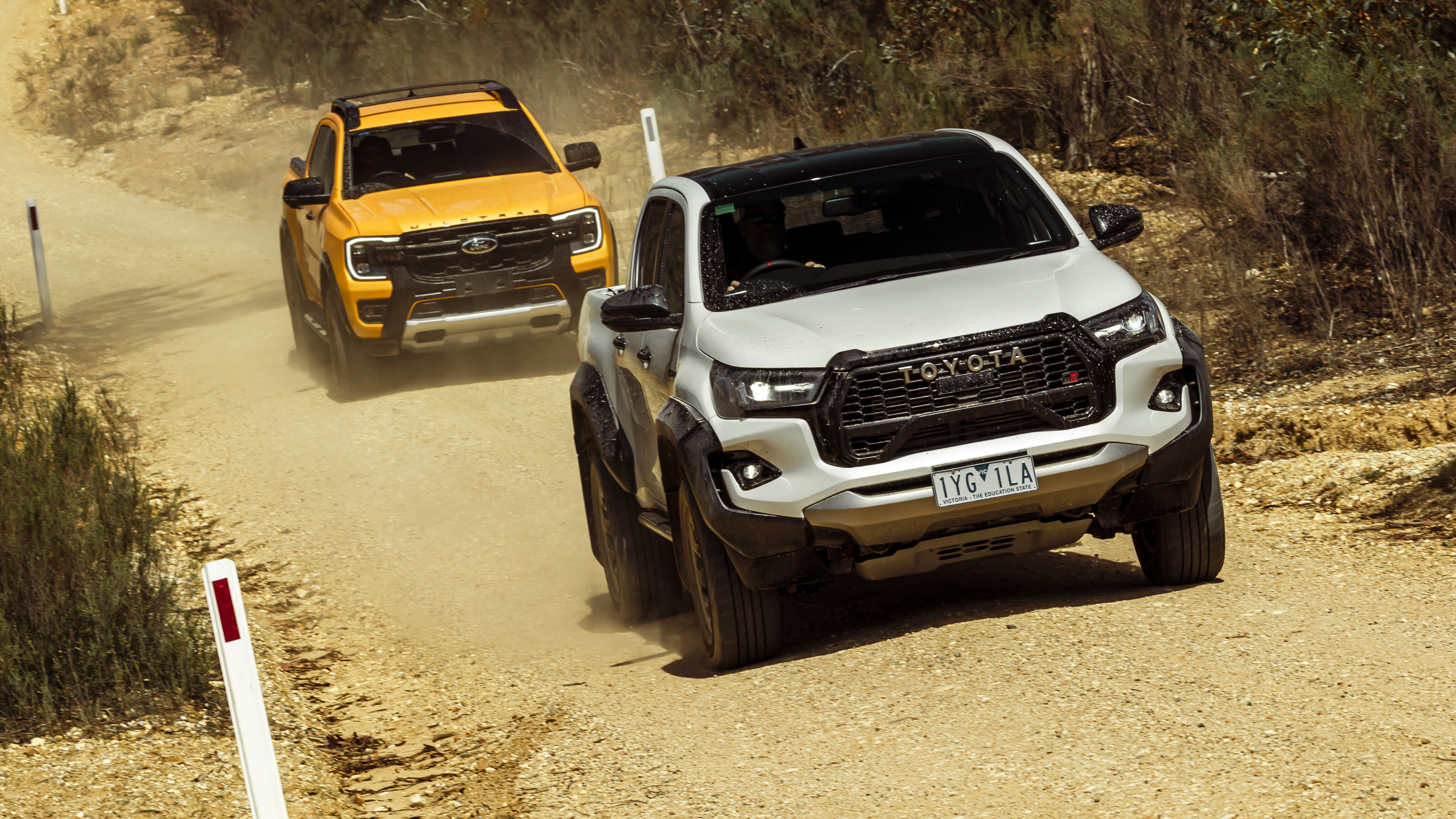
Toyota’s hero model is the HiLux GR Sport, which squares off evenly with Ford’s Wildtrak X model at $73,990 and $75,990 respectively (plus ORC).
While the GR Sport sits atop the HiLux list in terms of both price and equipment, the Wildtrak X is only the most expensive and best equipped of the four-cylinder Rangers, with the V6 Platinum and Raptor models sitting above it.
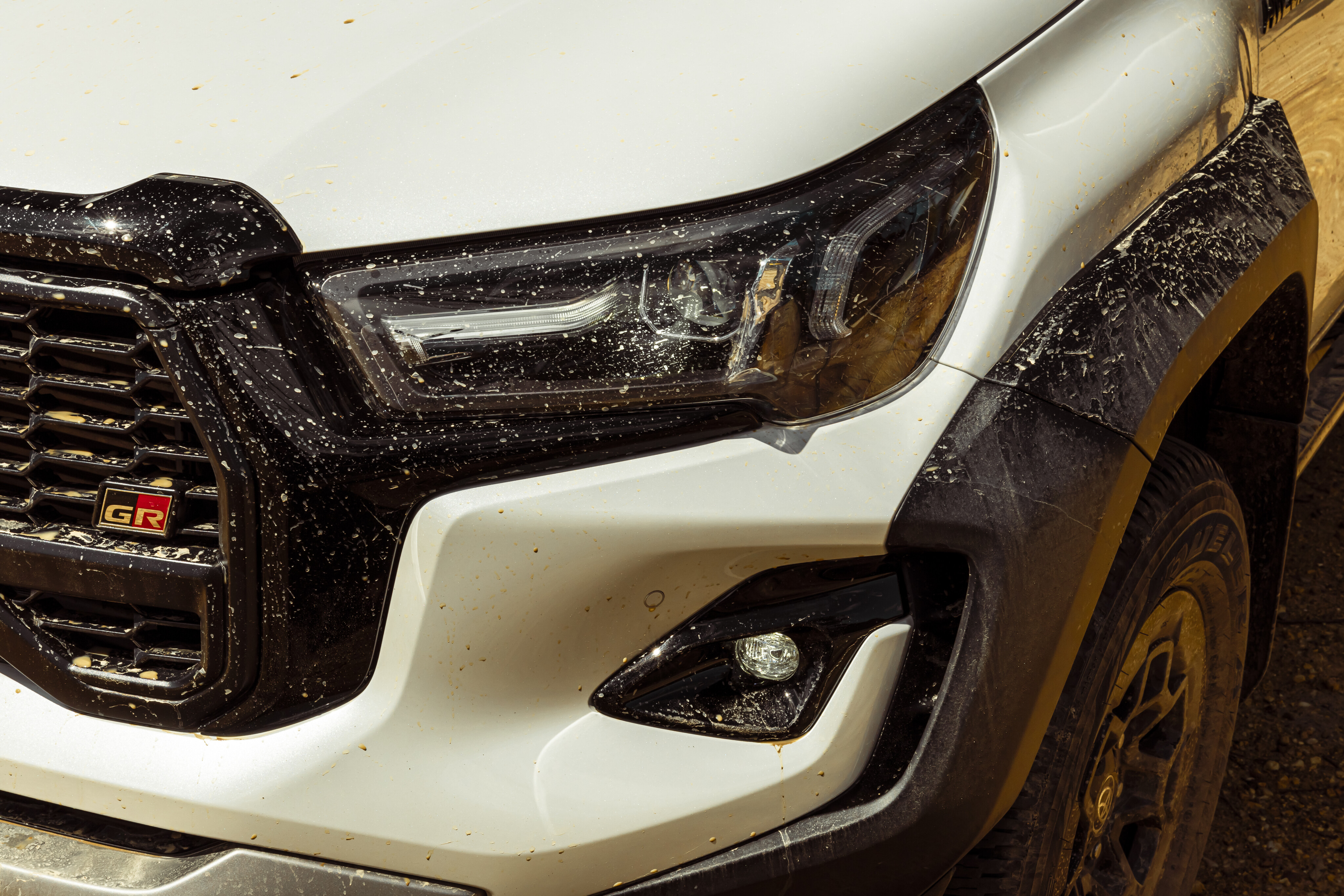
JUMP AHEAD
What do you get?
The HiLux GR Sport is based on the Rogue model which was previously the highest grade HiLux model.
As such it gets heated leather front seats but with GR-S specific suede trim and colours, nine-speaker JBL sound system, an eight-inch screen with inbuilt satnav and audio controls, plus Apple CarPlay and Android Auto, and a 360° panoramic camera.
There’s aluminium driver’s pedals and red seat belts, which we guess will appeal to someone, but don’t really add anything to the driving experience.
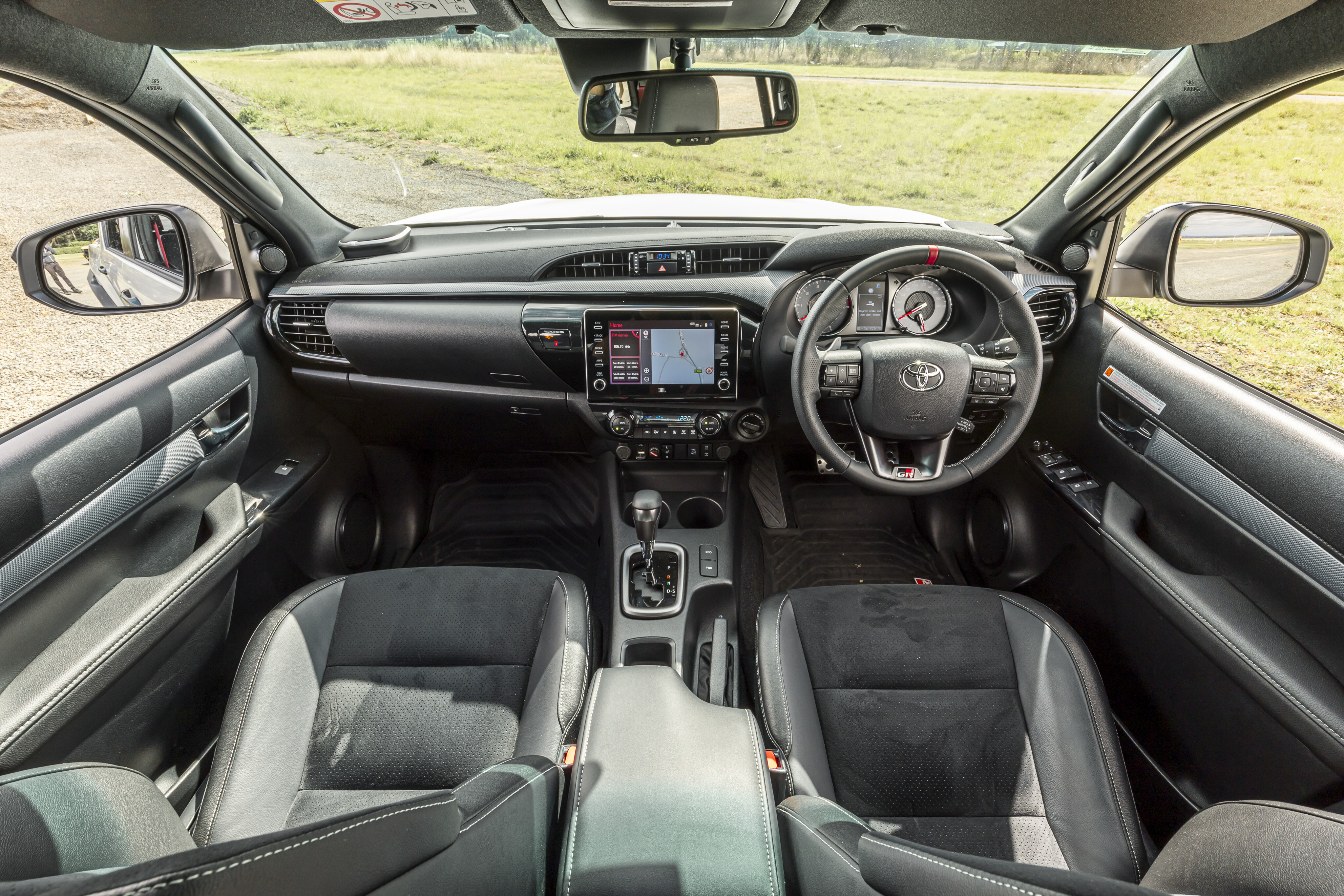
Toyota has dressed the HiLux interior in its Sunday best yet it remains basic and functional and that’s what we like about it. The only thing it’s really missing is reach adjustment on the steering column which is an indicator of the N80 HiLux’s age.
The Wildtrak X carries over the features you get in the V6 model Wildtrak including the big 12-inch centre screen, oversize configurable gauge screen, heated leather seats, wireless Carplay and Android Auto.
On the outside of the Wildtrak X you get matrix LED headlights up front and on the tub there is Ford’s new adjustable load bars that include a bar that slides back on the tub together with adjustable cross bars on the roof rails that combine to give a clever and useful, versatile load system for carrying longer items like surfboards.
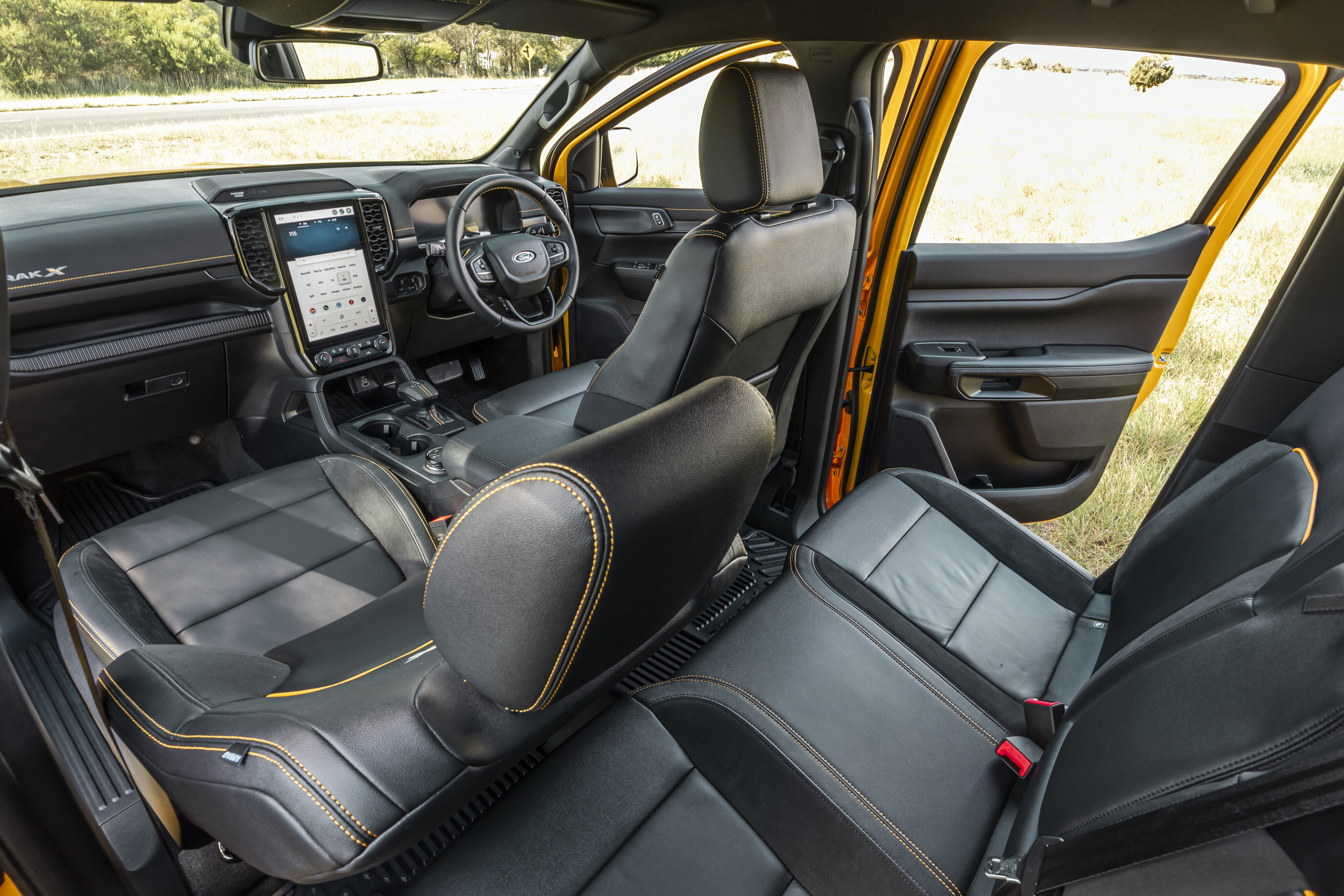
Safety
The HiLux GR Sport has safety essentials like ABS, ESC, ETC, AEB, trailer-sway control, blind-spot monitors and rear cross-traffic alert and radar cruise control, but it’s lane-departure system relies on brake intervention and doesn’t offer proper steering correction.
The improved dynamics provided by the GR Sport’s uprated suspension and the excellent four-wheel disc brakes should do a better job of keeping you safe than all the chassis electrickery.
The Wildtrak X is likewise loaded with much of the same chassis safety sorcery but the dynamic safety of the on-demand four-wheel drive system shouldn’t be underestimated, and the inclusion of a tyre pressure monitoring system is a huge plus.
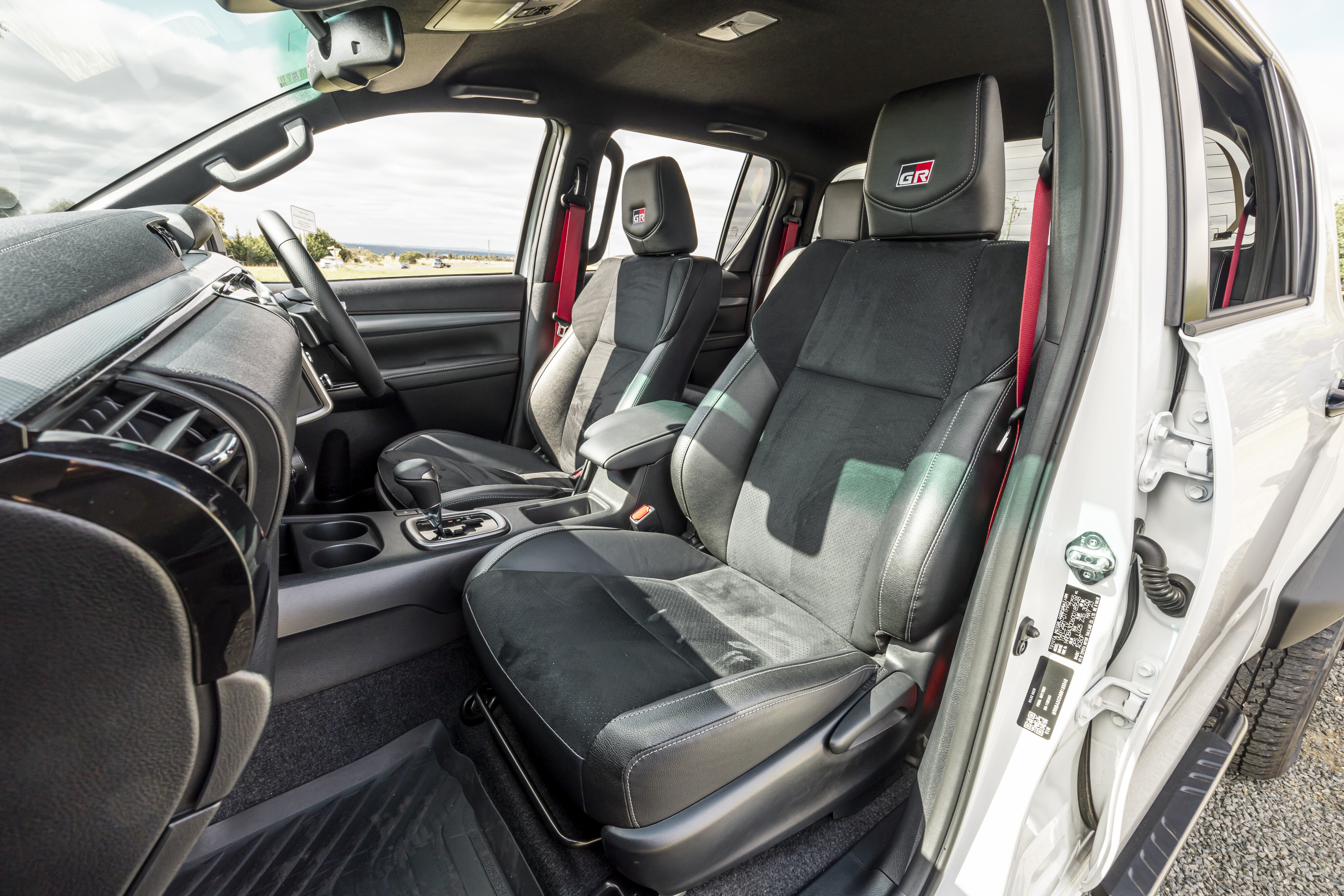
Powertrains and performance
Both of these utes are propelled by four-cylinder diesel engines backed by automatic transmissions.
The HiLux GR Sport (GR-S) is powered by the widely used 1GD 2.8-litre single turbo engine as found across the HiLux range as well as in the Prado, Fortuner and soon the LC70 range of 4x4s, plus some van and bus applications. The GR-S exclusively gets the highest output version of the engine offered to date with claimed outputs of 165kW and 550Nm, up from the standard 150kW and 500Nm.
The Aisin six-speed automatic transmission has been tweaked to best match the enhanced outputs and the driver gets paddle shifters behind the steering wheel for easier manual gear selection.
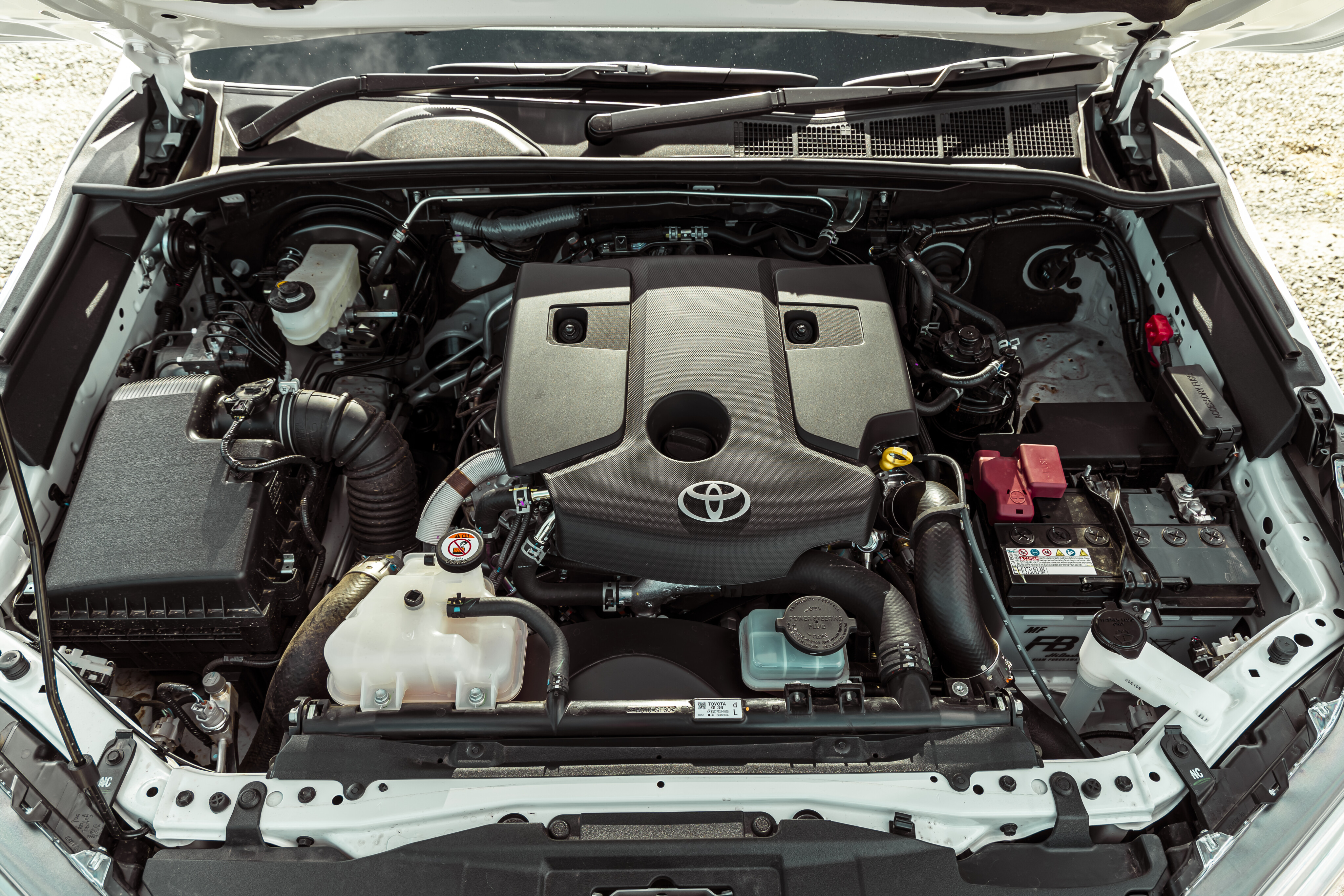
On gravel tracks where it was possible to select 4x4 in the part-time transfer case, it was stable and sure-footed, encouraging enthusiastic driving.
The 1GD has never been a slouch but the uprated outputs don’t go astray giving the GR-S plenty of punch when you put your foot down, with sharp response from the transmission. It’s a noisy and relatively harsh engine compared to newer and smaller-capacity diesels but this is a light commercial ute after all.
With fewer ratios in the transmission you really feel it when it kicks down or youshift back to make the most of the engine’s outputs, delivering an engaging and exciting driving experience.
We only drove it in unusually dry Melbourne conditions but I reckon it could be a handful on wet sealed roads. On gravel tracks where it was possible to select 4x4 in the part-time transfer case, it was stable and sure-footed, encouraging enthusiastic driving.
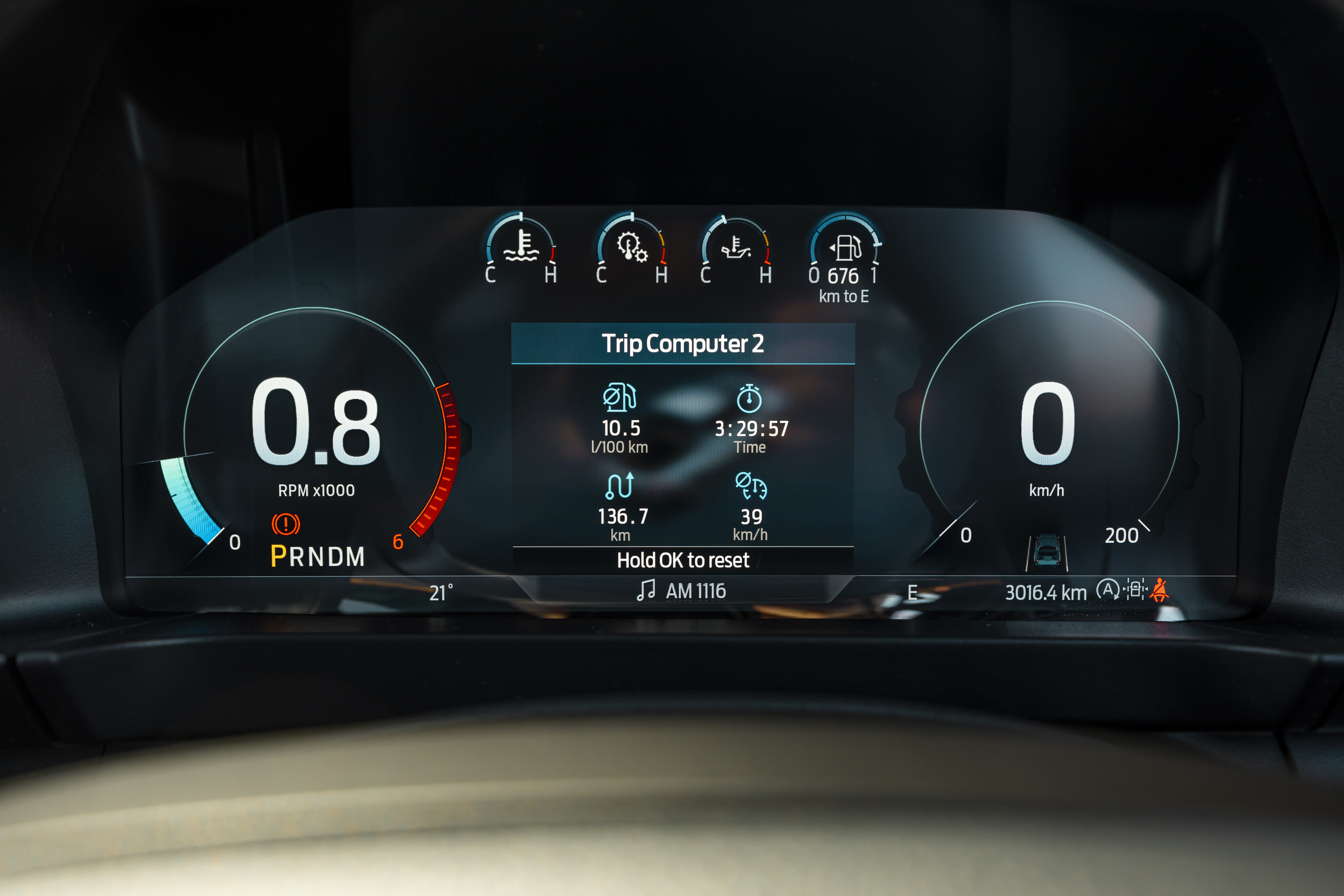
The Ranger Wildtrak X gets no special tuning for its 2.0-litre bi-turbo diesel engine and 10-speed transmission, making do with the standard 154kW and 500Nm.
It’s a much smoother, quieter and refined combination than that found in the Toyota, and it gets along quite well, but lacks the spirited feel that the GR-S delivers.
The Wildtrak X does get a shorter 3.73:1 final drive than other Ranger models to compensate for its taller tyres but it still feels a bit lacking in pick up when driven alongside the GR-S.
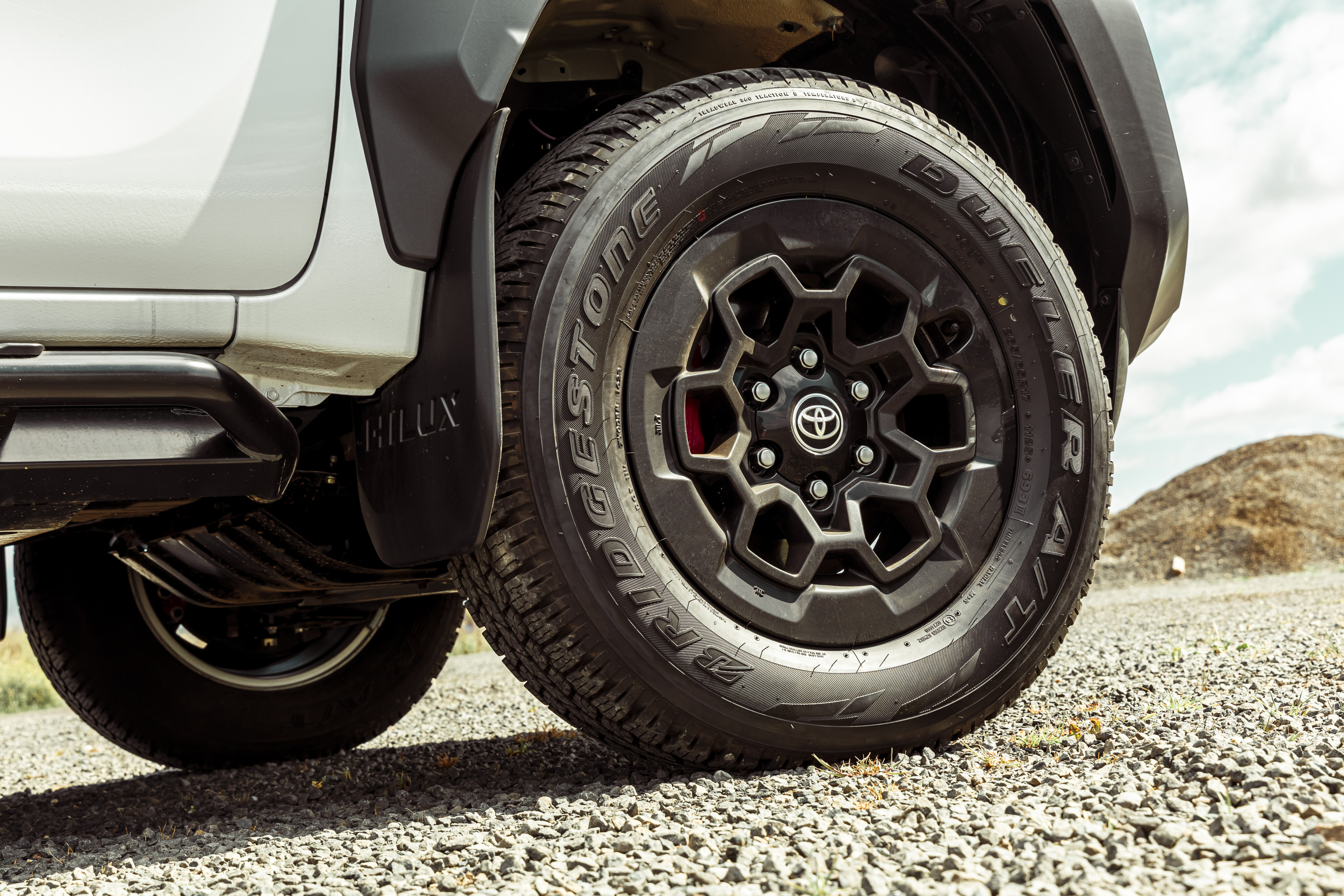
The 10-speed auto is more seamless in its operation with shifts going unnoticed and the closer ratios giving a far less aggressive feel.
The Ranger’s transfer case offers the option of using 4x4-auto mode on all road surfaces which is handy on varied road surfaces, in wet weather and especially when towing in stop/start traffic.
I terms of fuel consumption, Ford quotes a figure of 8.7L/100km on the combined cycle while Toyota rates the GR-S at 8.1L/100km which, interestingly, is better than the 8.4L/100km quoted for the similar but less powerful HiLux Rogue.

On-road ride and handling
Let’s cut to the chase here; the Ford Ranger is a far better on-road vehicle than the HiLux in any grade!
Its ride is more compliant and hence comfortable while also delivering superior dynamics and handling. It’s a more modern ute and feels more passenger car-like than the HiLux in every regard.
The HiLux GR-S, on the other hand, feels more like a traditional LCV in that it has a firm and sometimes jittery ride that can get tiresome on less than smooth surfaces.
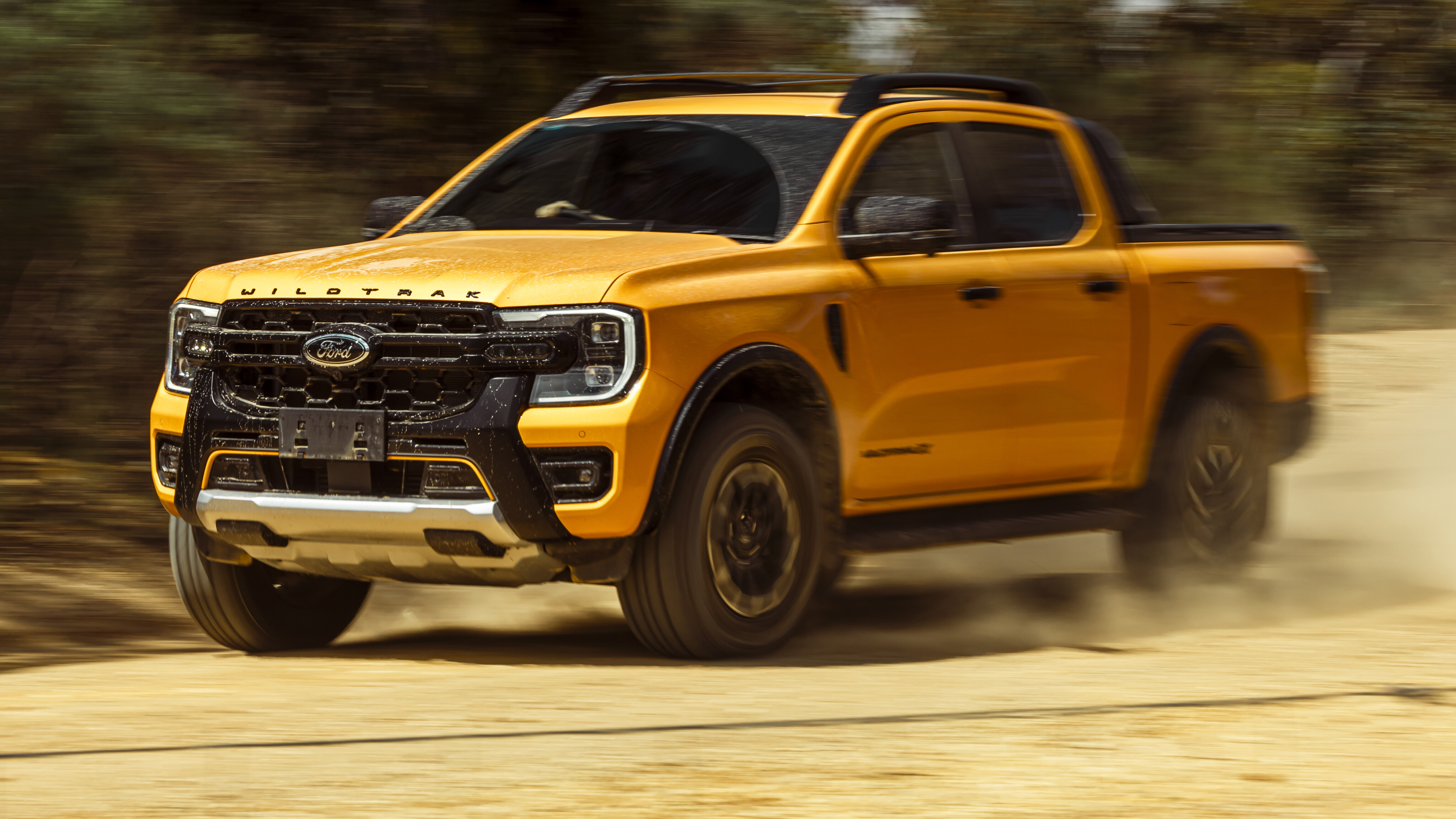
Each of these models get specific suspension designed to make them better handling over all conditions than their lower grade siblings and, in that regard, they are both very successful.
The HiLux GR-Sport gets the wider wheel track with extended front control arms and a wider rear axle that include disc brakes, that we first saw in the latest HiLux Rogue last year.
The difference between the two top-spec HiLux models is that the GR-S loses the Rogue’s rear sway bar to give it more rear axle articulation for better off-road performance and it comes with GR-S specific KYB monotube shock absorbers. They are matched to stiffer springs in the front and rear.
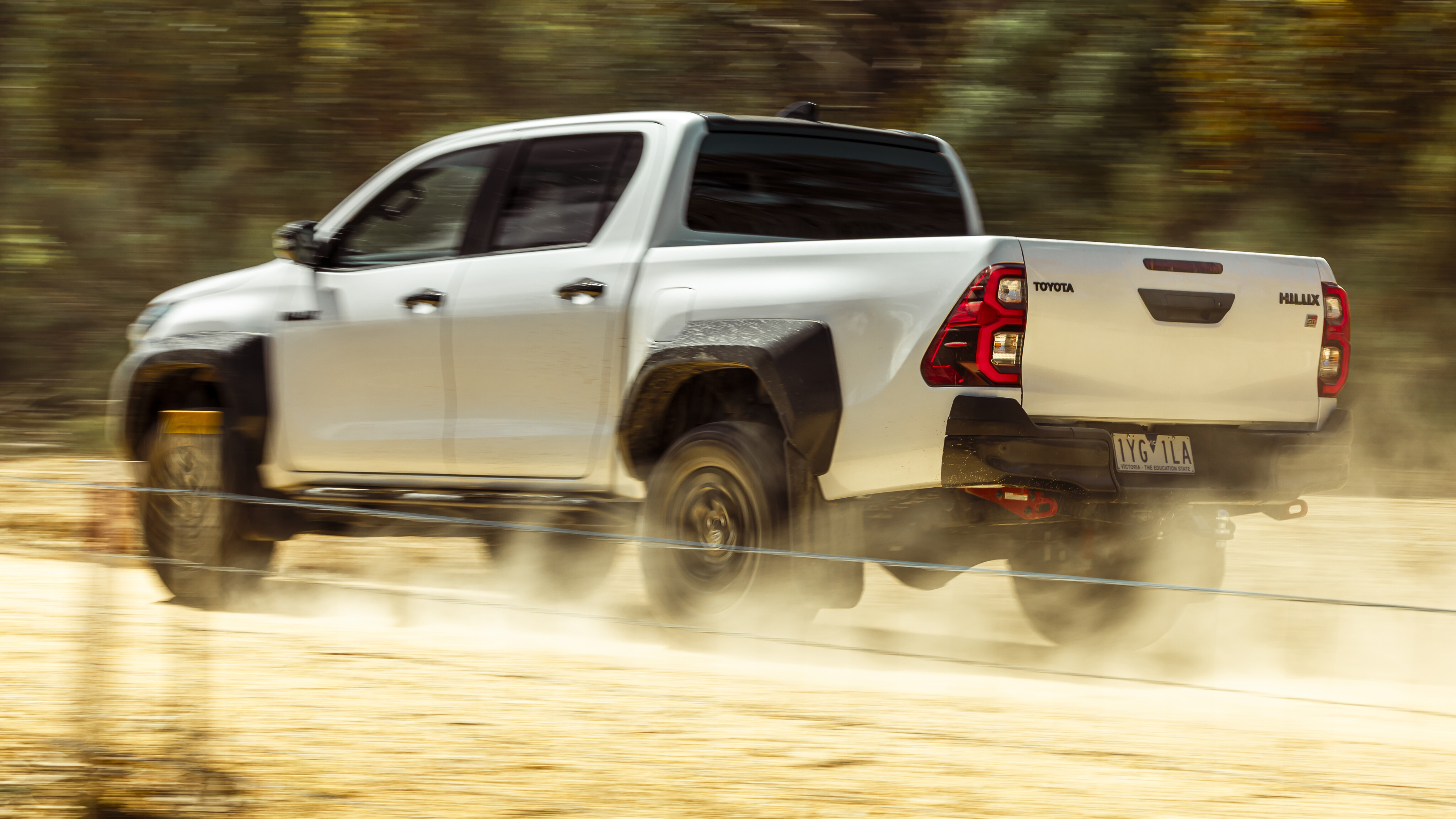
This setup does a great job on rough tracks with excellent control and damping but is still very firm around town on Melbourne’s far from smooth streets.
The Wildtrak X also benefits from bespoke dampers calibrated to give better rough-road performance. They come from premium shock specialist Bilstein and are position and frequency sensitive to give the best performance over any terrain.
The Ranger has superior ride, control and handling compared to the HiLux on most road surfaces and this carries over with these two model variants, but the GR-S delivers better control than the lower-spec HiLuxes.
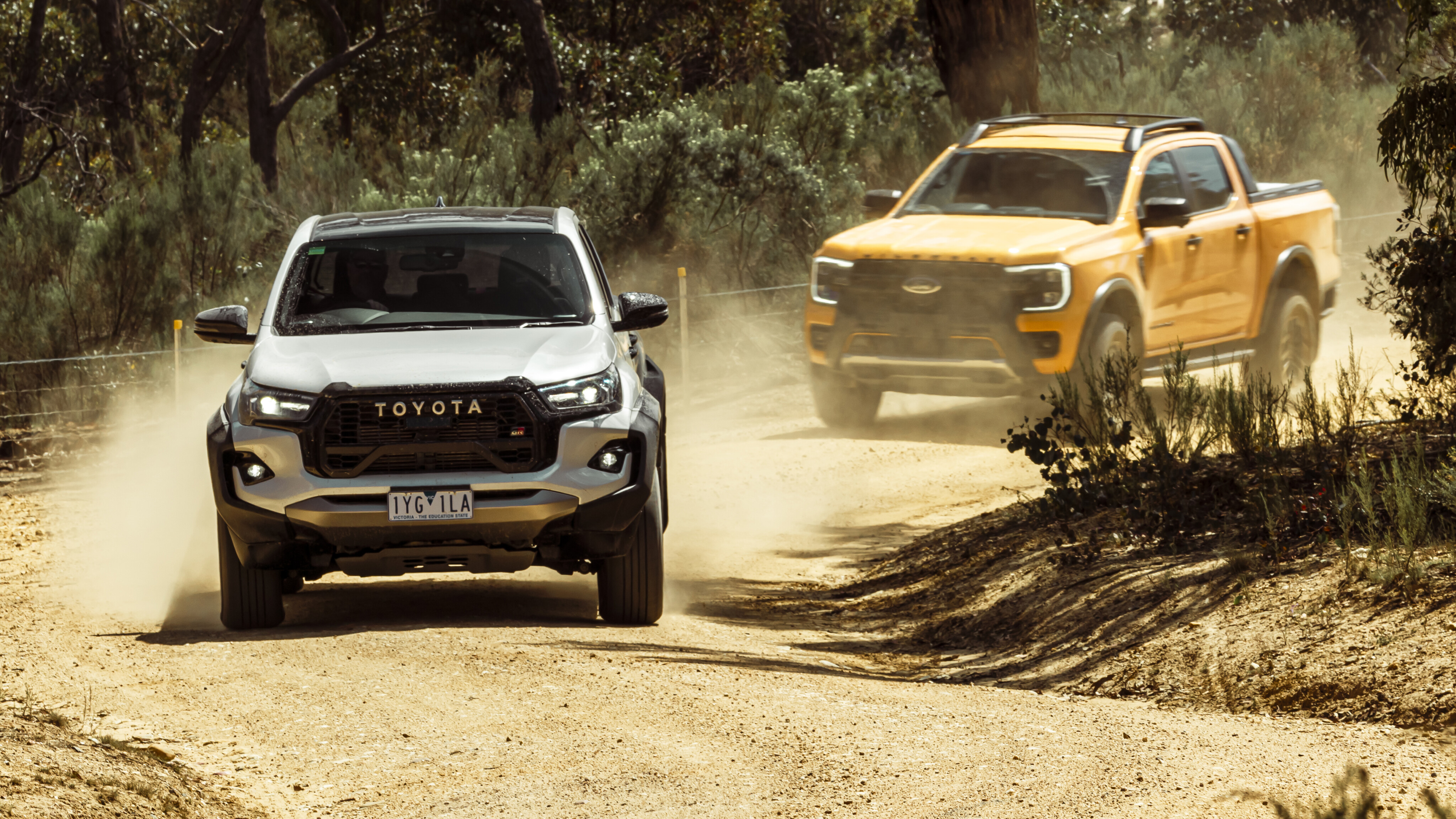
Off-road
As in so many other aspects, the HiLux and Ranger are at the top of their class in terms of off-road performance and these two specced-up models take that advantage to the next level.
No they are not true competitors to a Ranger Raptor but they are considerably less costly and come with the more popular diesel engines.
Without a Raptor-like model in the range the HiLux GR Sport is the off-road hero for Toyota’s midsize ute. As always its key attributes are relatively good rear-axle travel to keep the wheels on the ground and sharply calibrated electronic traction control. It also has a rear differential lock but the ETC does such a good job you rarely need to use it.
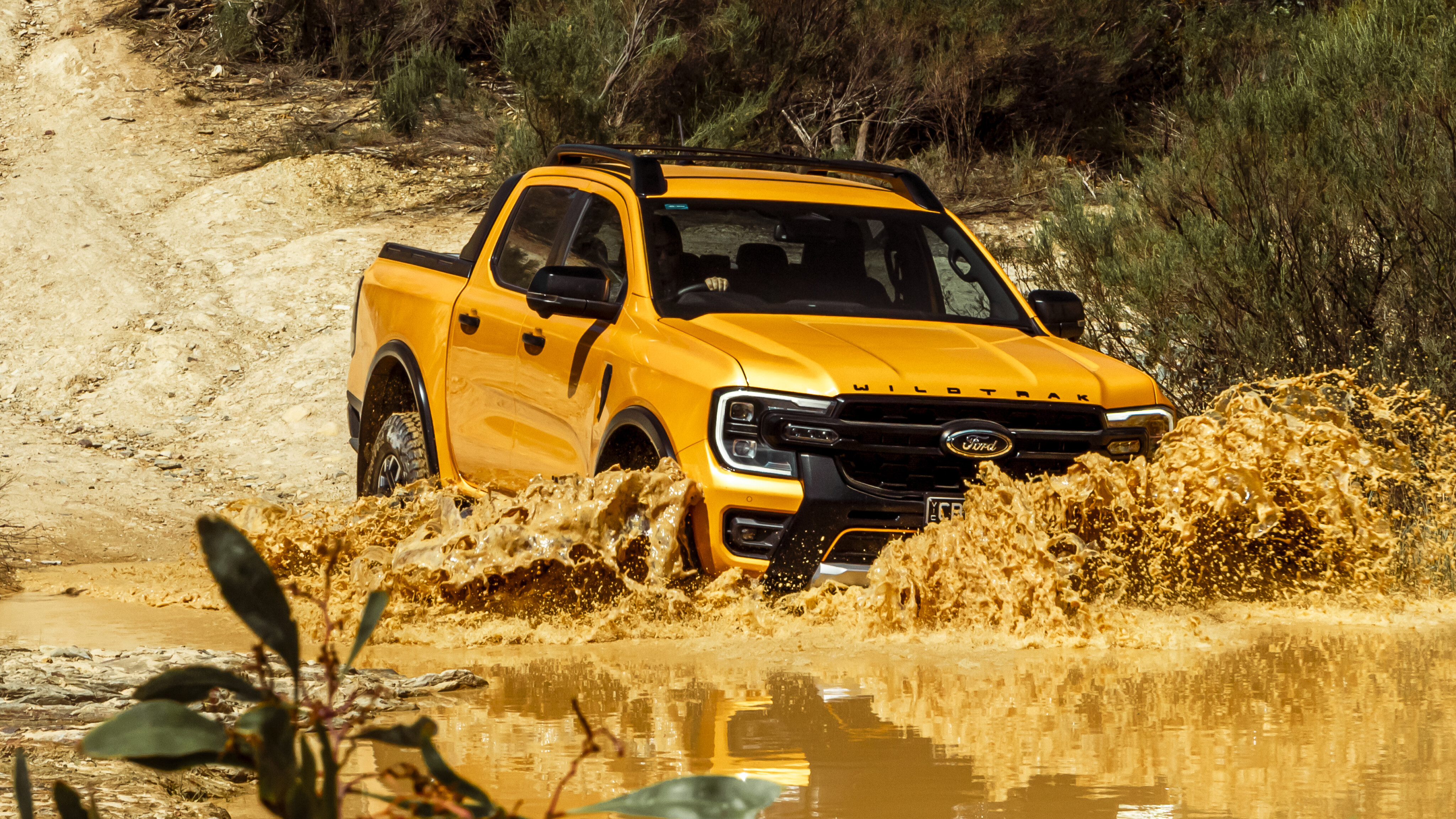
The rear axle in the GR-S benefits from the wider track and the placement of the shock absorbers further outboard than on regular HiLux models, and the lack of rear sway bar allows full extension.
This helps the Toyota get over deep ruts and obstacles with little wheel slip or drama.
Additional off-road hardware for the GR-S includes a model-specific front bumper that offers more ground clearance, a 4mm-thick pressed aluminium front skid plate,2mm tube steel rock sliders in lieu of side steps, and front and rear recovery points.
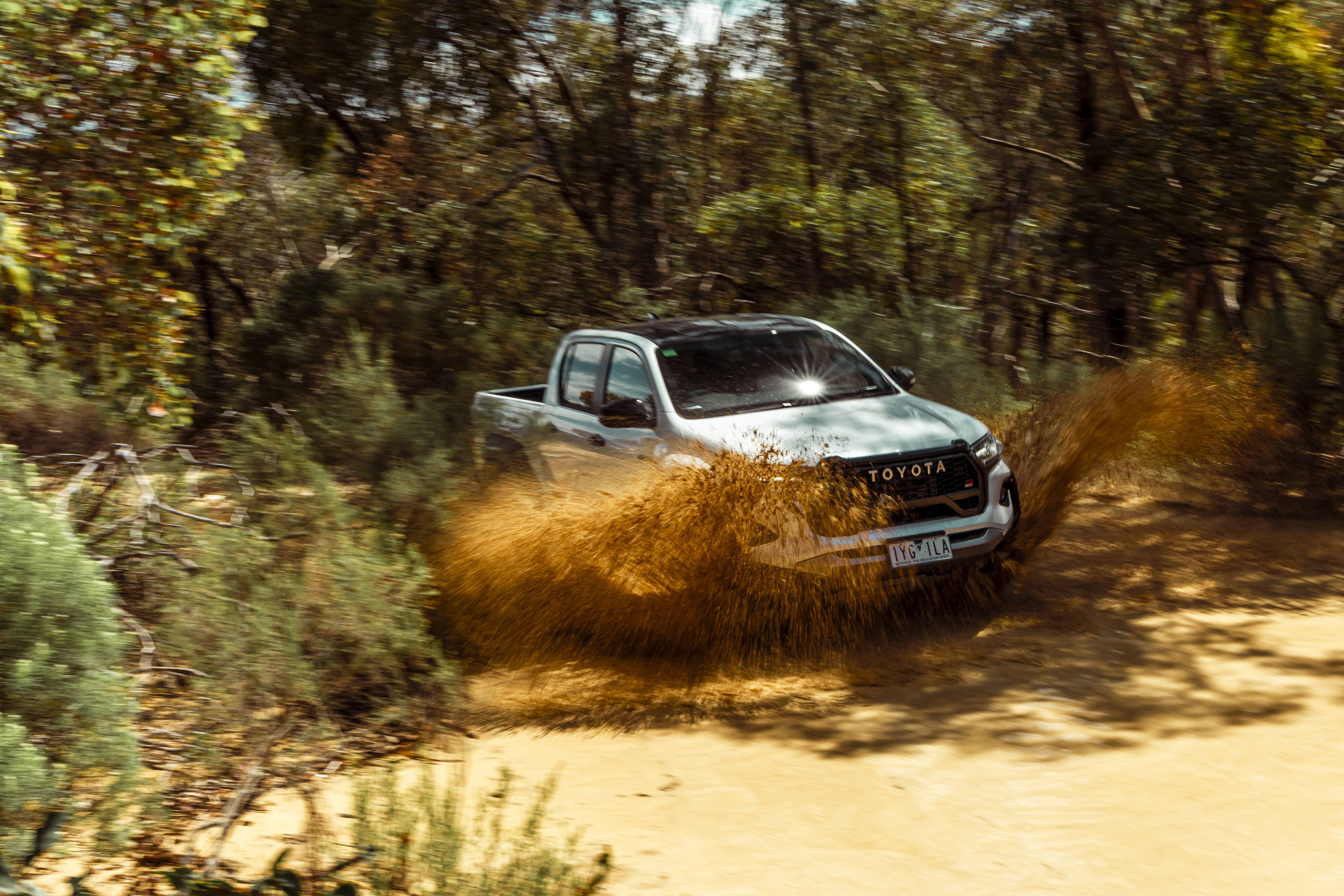
The GR Sport wears model-specific 17-inch alloy wheels wrapped in 265/65R17 Bridgestone Dueler all-terrain tyres. They are a relatively tame tread tyre, but quiet when on road.
The Wildtrak X Ranger also gets some off-road goodies on top of its bespoke Bilstein suspension.
Immediately obvious are its 265/70R17 Grabber AT3 tyres on alloy wheels, with the more aggressive tyres and suspension combining to give a 30mm wider front and rear wheel track, and an extra 26mm of ground clearance when compared a regular Ranger Wildtrak, while a steel bash plate helps protect the undercarriage.
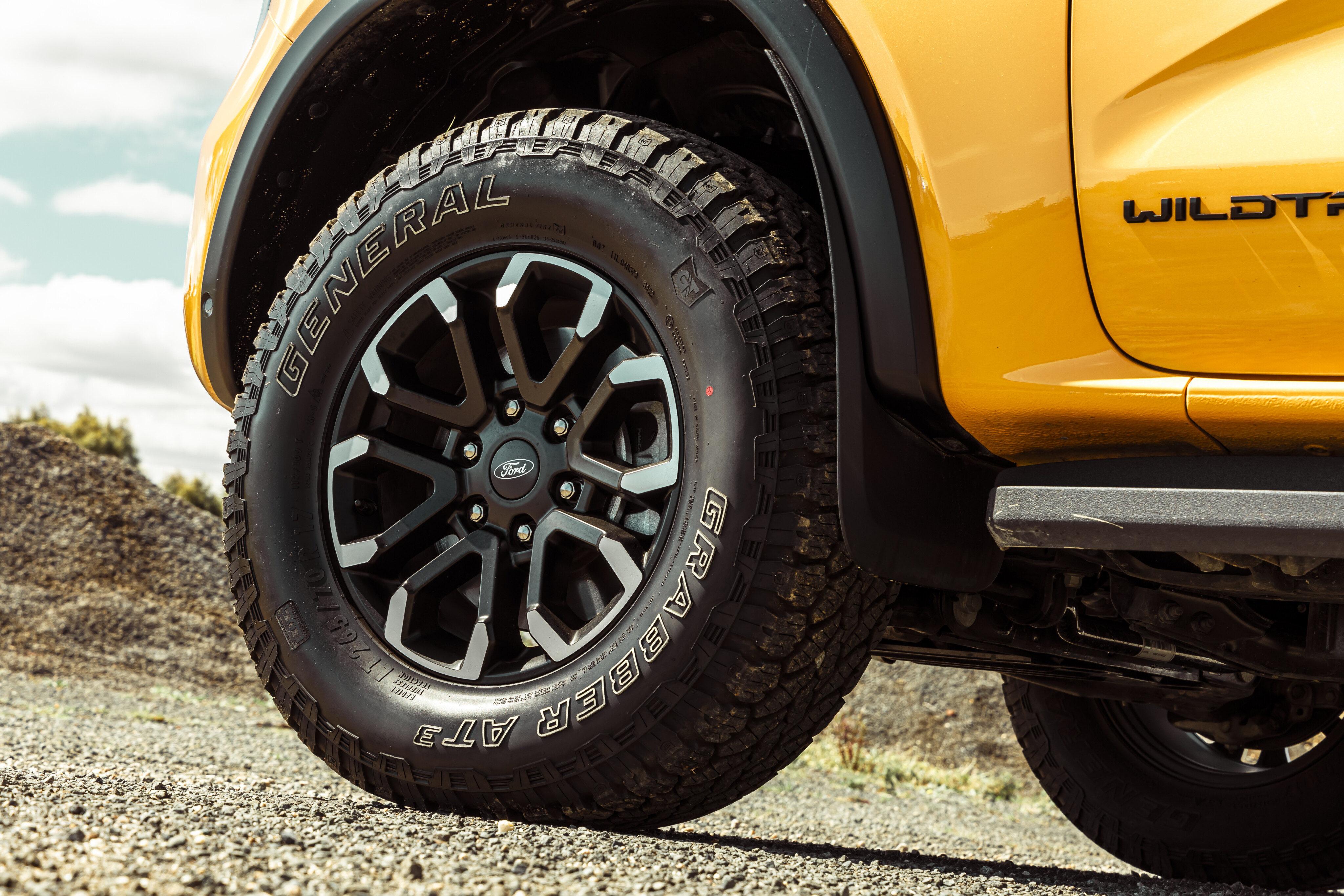
The Wildtrak X also benefits from some electronic extras to aid off-road performance including Trail Control and Trail Turn Assist.
The latter of these is new to Ranger and, as it does in LandCruiser 300 and GWM Tank vehicles, it locks the inside rear wheels to help decrease the turning circle when off road.
More useful than Turn Assist is Trail Control which like Toyota’s Crawl Control system, and one used by Jeep, works like low-speed cruise control for pedal-free progress over rough ground.
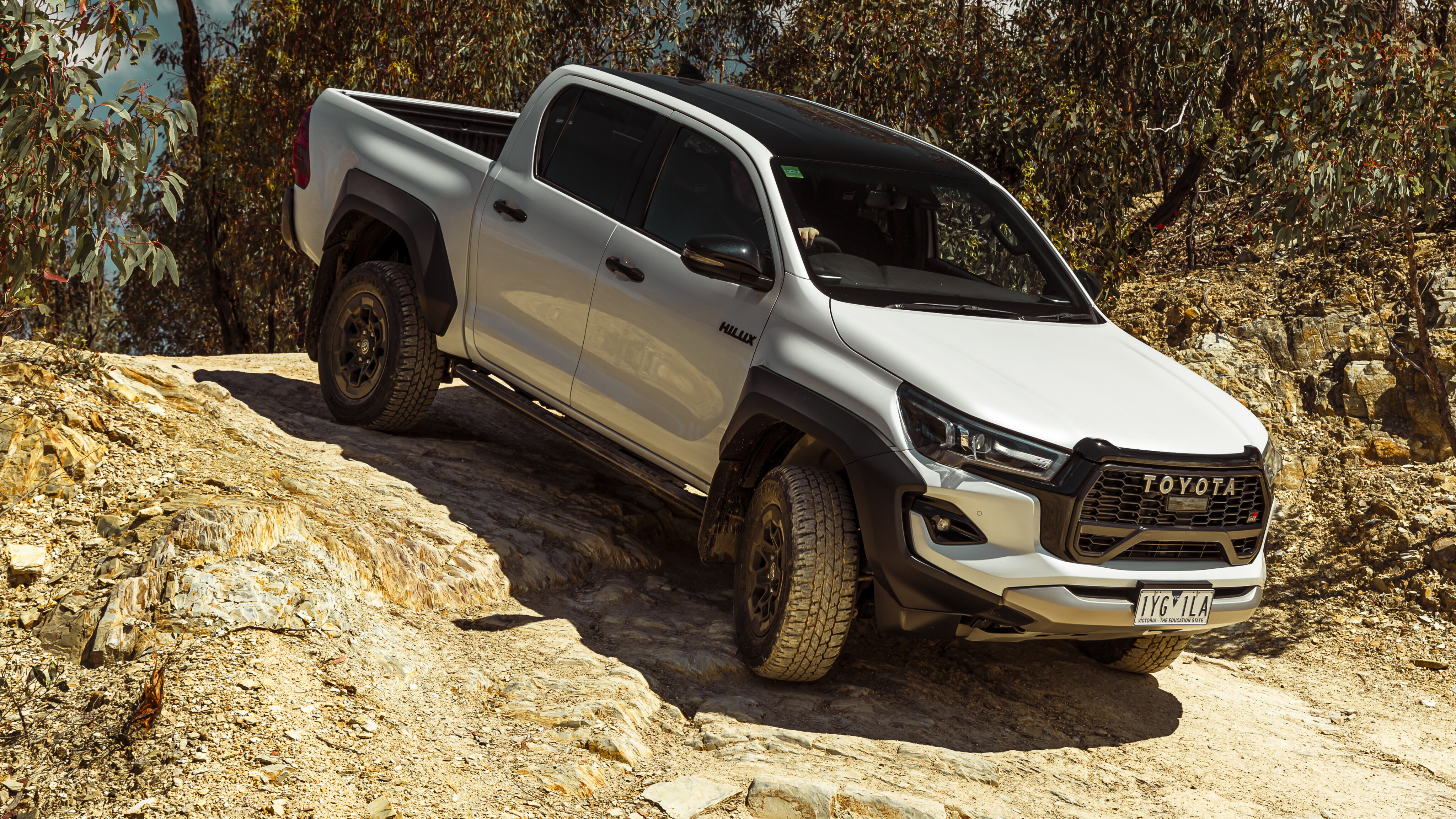
The biggest benefit of such systems is their ability to deliver micro throttle inputs calibrated to keep you moving at the set speed without too much throttle that could induce wheel spin.
It’s far more accurate in throttle application than the most experienced off-road driver’s right boot and it’s a shame Toyota hasn’t seen fit to add Crawl Control to the GR-S.
We set the Ford’s Trail Control to 2km/h when we pointed the X up a rutted climb and the Ranger edged its way up without a skerrick of tyre spin making light work of the drive much to the disappointment of photographer Al. Yes, the HiLux also drove up there using driver input on the accelerator but it wasn’t as smooth or controlled.

Verdict
There’s no doubt that this is the best HiLux you can drive away from a Toyota dealer today.
The braking and suspension improvements to the GR Sport make it the best-driving production HiLux both on- and off-road, while the minor increases in engine output don’t go astray either.
There’s also no hiding the fact the N80 HiLux is a generation behind the Ford Ranger… but that’s not such a bad thing. The Toyota 1GD engine might be rough and noisy but it’s punchy, and the six-speed transmission lets you feel what’s going on beneath the car. Yes, the Ford’s engine and transmission are more refined, but they don’t deliver the connectivity with the vehicle that you get in the HiLux.
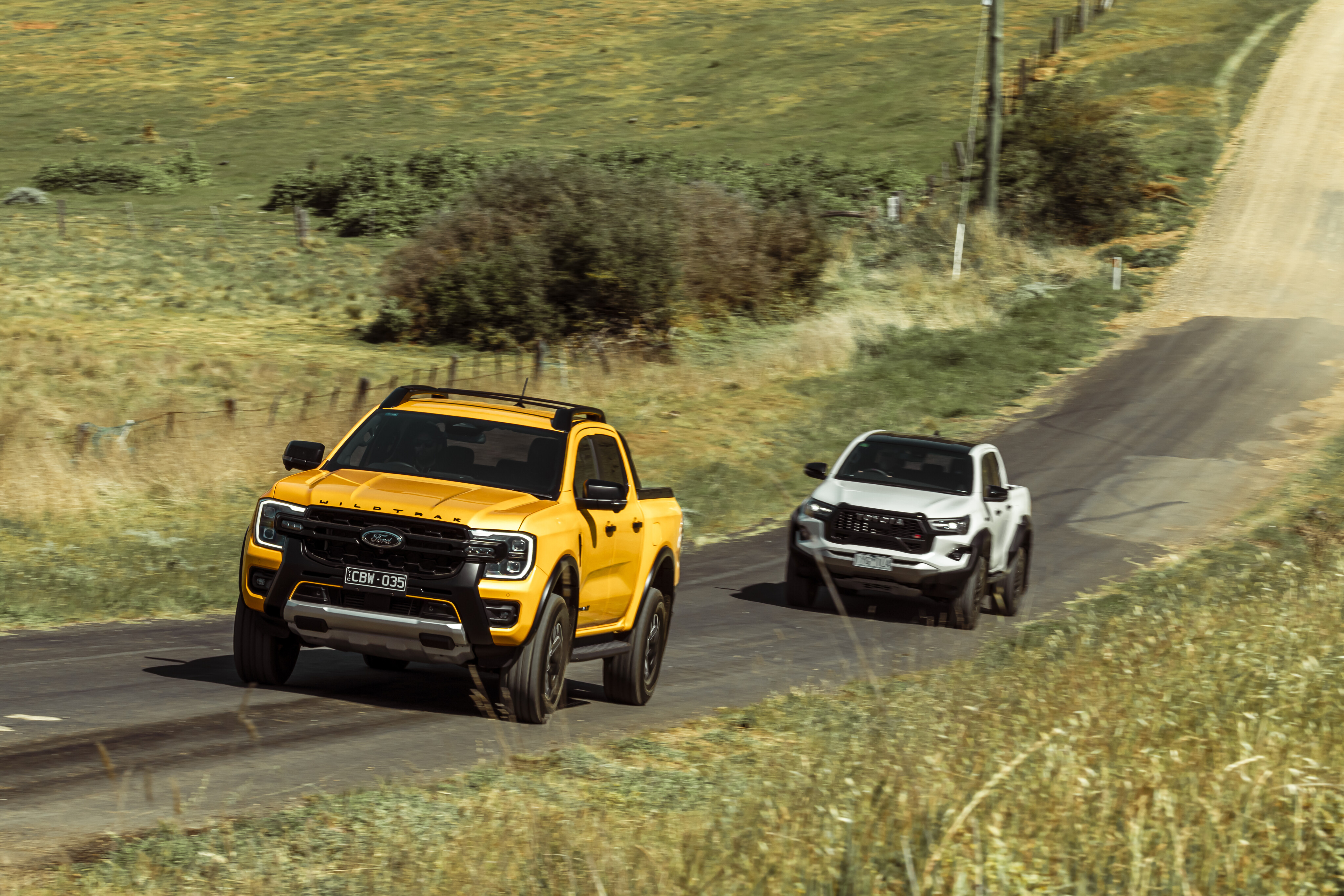
The same theme applies inside where the interior trim is less integrated and overall size is smaller, but sometimes less is more and the analogue driver’s gauges are simpler and easier to read and many of the systems are easier to navigate.
The HiLux does fall behind when you look at the payload in the highly equipped GR Sport model, and both of these utes retain their 3500kg rated towing capacity.
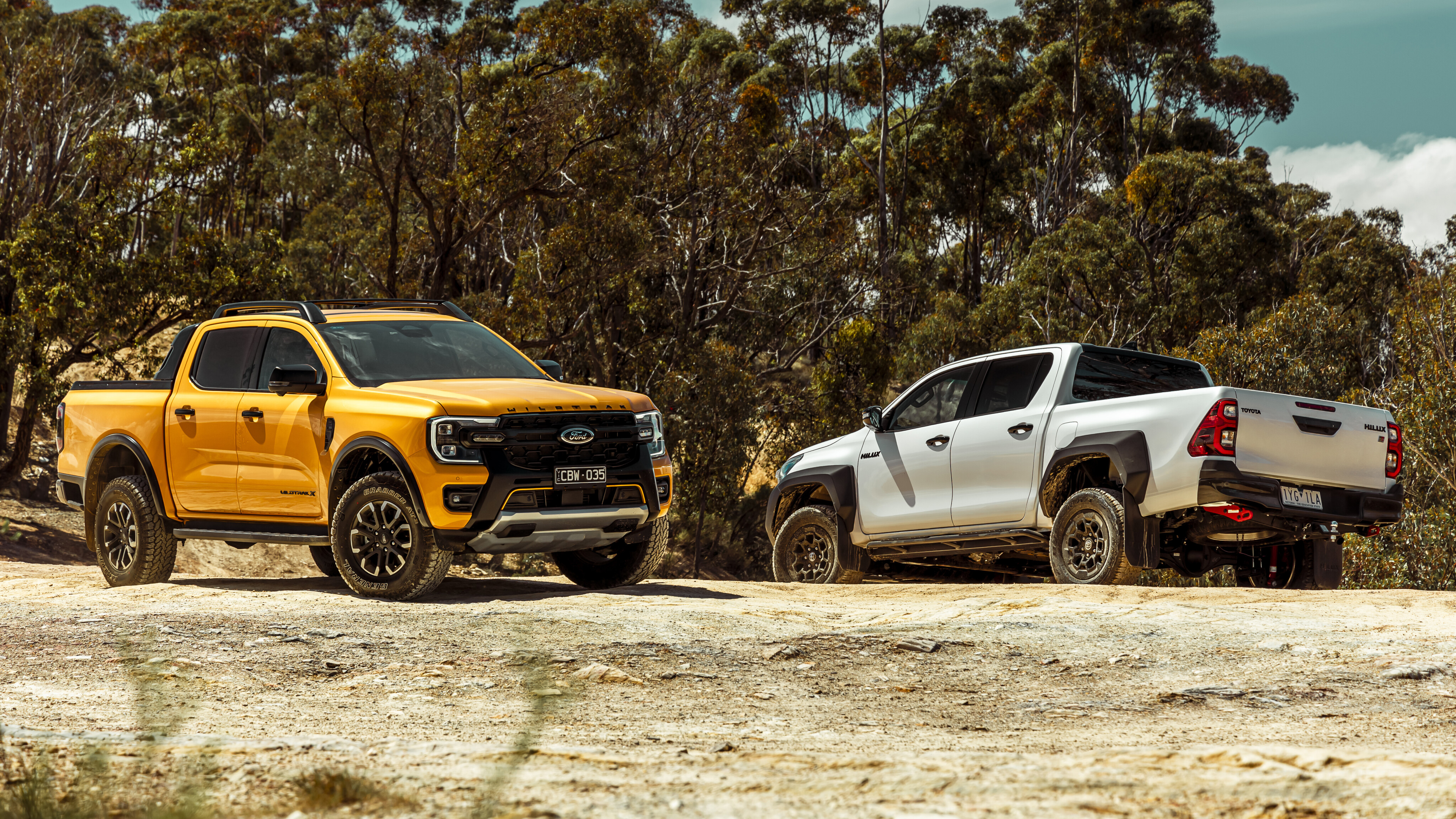
For most prospective buyers the Wildtrak X offers a much more appealing choice.
The Ranger’s newer design shines through in the interior space, the levels of equipment, safety features, on-demand four-wheel drive system, towing tech, dynamics and refinement. There’s no denying that this is the current leader in dual-sport 4x4 ute design with or without the V6 engine.
The GR Sport does bring the HiLux a lot closer to the Ranger in terms of modernity and ability but the Wildtrak X edges it out in this comparison.
| Ford Ranger Wildtrak X | Toyota HiLux GR Sport | |
|---|---|---|
| Price | $73,990 | $75,990 |
| Engine | Inline 4 –cyl diesel, twin turbocharger | Inline 4 –cyl diesel, single turbocharger |
| Capacity | 1995cc | 2755cc |
| Max power | 154kW @3750 | 165kW @ 3000rpm |
| Max torque | 500NM from 1750-2000pm | 550Nm from 1600-2800rpm |
| Transmission | 10-speed auto | 6-speed auto |
| 4x4 system | On demand 4x4 with auto and dual range 4x4 | Part time, dual range 4x4 |
| Crawl ratio | 36:1 | 36.1:1 |
| Construction | 4-door ute body on separate chassis | 4-door ute body on separate chassis |
| Front suspension | IFS with wishbones and coils | IFS with wishbones and coils |
| Rear suspension | Live axle on leaf springs | Live axle on leaf springs |
| Tyres | 265/70R17 on alloy wheels | 265/65R17 on alloy wheels |
| Weight | 2432kg kerb | 2270kg kerb |
| GVM | 3350kg | 3050kg |
| GCM | 6350kg | 5850kg |
| Towing capacity | 3500kg | 3500kg |
| Payload | 918kg | 780kg |
| Seats | 5 | 5 |
| Fuel tank | 80L | 80L |
| ADR fuel consumption | 8.7L/100km (claimed) | 8.1L/100km (claimed) |
| Approach angle | 32° | 30° |
| Ramp over angle | 24° | |
| Departure angle | 24.1° | 23° |
| Ground clearance | 261mm | 265mm |
| Wading depth | 800mm | NA |



COMMENTS